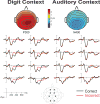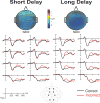When 2 × 4 is meaningful: the N400 and P300 reveal operand format effects in multiplication verification
- PMID: 30132910
- PMCID: PMC6193826
- DOI: 10.1111/psyp.13212
When 2 × 4 is meaningful: the N400 and P300 reveal operand format effects in multiplication verification
Abstract
Arithmetic problems share many surface-level features with typical sentences. They assert information about the world, and readers can evaluate this information for sensibility by consulting their memories as the statement unfolds. When people encounter the solution to the problem 3 × 4, the brain elicits a robust ERP effect as a function of answer expectancy (12 being the expected completion; 15 being unexpected). Initially, this was labeled an N400 effect, implying that semantic memory had been accessed. Subsequent work suggested instead that the effect was driven by a target P300 to the correct solutions. The current study manipulates operand format to differentially promote access to language-based semantic representations of arithmetic. Operands were presented either as spoken number words or as sequential Arabic numerals. The critical solution was always an Arabic numeral. In Experiment 1, the correctness of solutions preceded by spoken operands modulated N400 amplitude, whereas solutions preceded by Arabic numerals elicited a P300 for correct problems. In Experiment 2, using only spoken operands, the delay between the second operand and the Arabic numeral solution was manipulated to determine if additional processing time would result in a P300. With a longer delay, an earlier N400 and no distinct P300 were observed. In brief, highly familiar digit operands promoted target detection, whereas spoken numbers promoted semantic level processing-even when solution format itself was held constant. This provides evidence that the brain can process arithmetic fact information at different levels of representational meaningfulness as a function of symbolic format.
Keywords: ERPs; N400; P300; arithmetic; numerical cognition; spoken number words.
© 2018 Society for Psychophysiological Research.
Figures







Similar articles
-
P300 amplitude and latency reflect arithmetic skill: An ERP study of the problem size effect.Biol Psychol. 2019 Nov;148:107745. doi: 10.1016/j.biopsycho.2019.107745. Epub 2019 Aug 27. Biol Psychol. 2019. PMID: 31470071 Free PMC article.
-
Bilingual children access multiplication facts from semantic memory equivalently across languages: Evidence from the N400.Brain Lang. 2019 Nov;198:104679. doi: 10.1016/j.bandl.2019.104679. Epub 2019 Aug 21. Brain Lang. 2019. PMID: 31445417 Free PMC article.
-
Development is in the details: Event-related theta oscillations reveal children and adults verify multiplication facts differently.Psychophysiology. 2023 Jun;60(6):e14255. doi: 10.1111/psyp.14255. Epub 2023 Feb 8. Psychophysiology. 2023. PMID: 36752305 Free PMC article.
-
Thirty years and counting: finding meaning in the N400 component of the event-related brain potential (ERP).Annu Rev Psychol. 2011;62:621-47. doi: 10.1146/annurev.psych.093008.131123. Annu Rev Psychol. 2011. PMID: 20809790 Free PMC article. Review.
-
"Compacted" procedures for adults' simple addition: A review and critique of the evidence.Psychon Bull Rev. 2018 Apr;25(2):739-753. doi: 10.3758/s13423-017-1328-2. Psychon Bull Rev. 2018. PMID: 28600718 Review.
Cited by
-
Related consistent lures increase the judgment of multiplication facts: Evidence using event-related potential technique.Front Neurosci. 2023 Mar 31;17:1084309. doi: 10.3389/fnins.2023.1084309. eCollection 2023. Front Neurosci. 2023. PMID: 37065910 Free PMC article.
-
Comparing Clinically Applicable Behavioral and Electrophysiological Measures of Speech Detection, Discrimination, and Comprehension.Trends Hear. 2022 Jan-Dec;26:23312165221139733. doi: 10.1177/23312165221139733. Trends Hear. 2022. PMID: 36423251 Free PMC article.
-
When multiplying is meaningful in memory: Electrophysiological signature of the problem size effect in children.J Exp Child Psychol. 2022 Jul;219:105399. doi: 10.1016/j.jecp.2022.105399. Epub 2022 Feb 26. J Exp Child Psychol. 2022. PMID: 35231834 Free PMC article.
-
Reevaluating the Language of Learning Advantage in Bilingual Arithmetic: An ERP Study on Spoken Multiplication Verification.Brain Sci. 2022 Apr 21;12(5):532. doi: 10.3390/brainsci12050532. Brain Sci. 2022. PMID: 35624920 Free PMC article.
-
Arithmetic in the Bilingual Brain: Language of Learning and Language Experience Effects on Simple Arithmetic in Children and Adults.Mind Brain Educ. 2024 Aug;18(3):373-381. doi: 10.1111/mbe.12386. Epub 2023 Oct 13. Mind Brain Educ. 2024. PMID: 39290453 Free PMC article.
References
-
- Bassok M, Fisher K, Osterhout L. Conceptual integration in arithmetic is the same for digits and words: It’s the meaning, stupid! In: Taatgen NA, Van Rijn H, Schomaker LB, Nerbonne J, editors. Proceedings of the 31st Annual Conference of the Cognitive Science Society. Austin, TX: Cognitive Science Society; 2009. pp. 2142–2147. Retrieved from https://escholarship.org/uc/item/6h32m8mp.
Publication types
MeSH terms
Grants and funding
LinkOut - more resources
Full Text Sources
Other Literature Sources
Miscellaneous

